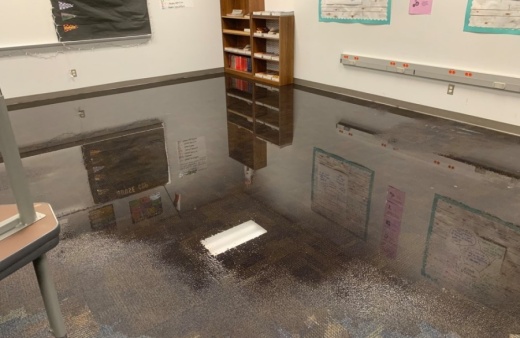Grapevine-Colleyville ISD
Heritage Middle School received the worst of the damage among district campuses. A ruptured pipe in the hallway between the main building and the fine arts building caused extensive water damage to seventh- and eighth-grade classrooms. Standing water up to 2 inches deep damaged some of the classrooms in the fine arts building as well, according to a presentation given by Chief Operations Officer Paula Barbaroux at a Feb. 22 board of trustees meeting.
“It was just too much water that stood for a period of time,” Barbaroux said. “When you have water that stands for an hour—much less two hours, in some cases—you know it's going to lead to additional weather damage.”
Sixth-grade Heritage students returned to class Feb. 22, and the older grades transitioned to remote learning for the week. As of Feb. 23, the school district is still working on a long-term plan for those students, said Kristin Snively, GCISD executive director of communications.
The damage was also extensive at the GCISD Early Childhood Development Center, which provides care and education for young children of district employees. A burst sprinkler flooded the building at 5101 Heritage Ave., Colleyville, and the center was temporarily relocated to Cross Timbers Middle School.
Burst pipes at Grapevine Middle School and Grapevine High School also affected classrooms. The district said in a Feb. 19 statement to families that some students would be relocated.
In addition, two boilers at Colleyville Middle School had to be replaced, and some schools, including Bear Creek Elementary School and the Bridges Accelerated Learning Center, were affected by a Spectrum network outage.
As of Feb. 22, network services had been restored to all schools, Chief Technology Officer Kyle Berger said at the Feb. 22 board meeting.
“The amount of alarms and alerts and all these things that were going off—the team was on constant rotation from site to site,” Berger said. “The team ... [works] hand in hand with the facilities and operations team."
Only Bransford, Cannon, Colleyville and Timberline elementary schools went without damage, officials said.
Snively added that the district is still working to assess the damage and that the full cost of repairs is still unknown. The Texas Association of School Boards Risk Management Fund, which insures the district, will help cover property and casualty damage.
Carroll ISD
Carroll ISD incurred damage, including burst pipes and sprinklers, at several campuses, including Carroll Senior High, Rockenbaugh Elementary, Durham Intermediate, Johnson Elementary, Dragon Stadium and the Administration Center.
In a Feb. 20 Facebook post, CISD Superintendent Lane Ledbetter said facilities department staff worked through the weekend to address issues and allow the district to reopen Feb. 22.
“It was a very trying time and a very frustrating time for all of us in the community,” Ledbetter said in a board update Feb. 22.
Matt Miller, CISD assistant superintendent for administrative services, said that staff preparation of campuses helped mitigate major damages that could have happened as a result of freezing temperatures.
“All the major [issues] were caught within hours by our staff,” Miller said. “So we were immediately able to cut the water off, get the water cleaned up, get the fans on and get it dried out. Even though we had rolling outages, we had enough power in the buildings to keep the airflow going [and] keep the heat on at times, [which] was enough to get things dried out quickly.”
Estimated costs for repairs have yet to be determined as minor leaks continue to be found in some places. Miller said the current estimate is $100,000, but that number could change depending on the costs for plumbers, overtime staff and vendors for needed materials.
“The pipe leak fixes—that's probably where most costs are going to be,” he said. “[It's] nothing like other districts are dealing with. We've been able to mitigate that pretty well.”






